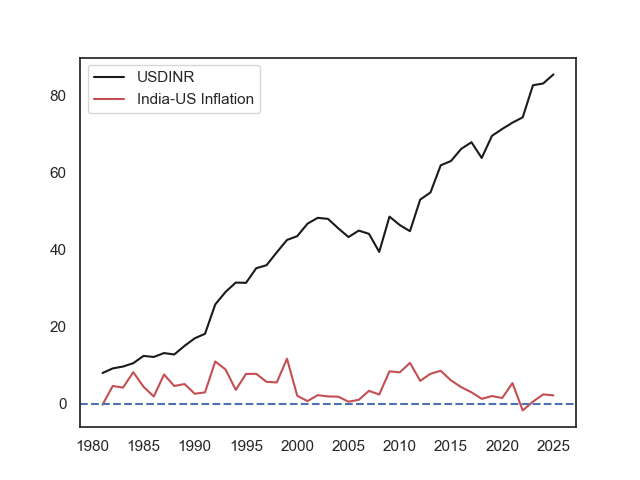Suppose you ask me to predict whether the stock market will be higher or lower tomorrow. My guess is as good as a coin flip. If instead you ask me whether the stock market will be higher or lower ten years from now, I can do better. In fact, I’m almost certain the stock market will be higher ten years from now, compared to today.
With exchange rates, a similar principle applies. USDINR, the exchange rate that measures the number of rupees per one dollar, fluctuates daily. Like the stock market, daily changes are difficult to predict. But what about the value of USDINR ten years from now? Do we know whether it will be higher or lower? Is it as simple as the stock market going up over time?
In turns out that it’s not as simple. This is because over time, some currencies appreciate (increase in value), while others depreciate (decrease in value). But we can still make a good guess as to whether the rupee will go up or down in value in the long run. Critically, what matters for exchange rates in the long run is inflation. Inflation is a direct measure of the decline in a currency’s purchasing power. If inflation was 5% over the last year, the currency is 5% less valuable today compared to a year ago.
Then, what matters for exchange rates is the relative inflation between two countries. If a country has a higher inflation rate, its currency will depreciate. If a country has a lower inflation rate, its currency will appreciate. Let’s see if this theory helps us explain the behavior of USDINR.
US Dollar towers over the Indian Rupee
Here is a plot of USDINR over the last forty-five years in the black line. In 1981, one dollar bought 8 rupees. As of end of 2024, one dollar bought 85 rupees. The blue line plots the difference between Indian and US inflation. When this is above zero, Indian inflation is higher.

Clearly, the dollar has done up in value, while the rupee has declined. On average, the rupee depreciates by 5.3% per year, relative to the dollar. What about inflation? In almost every year, Indian inflation exceeds US inflation. On average, India’s inflation exceeds US inflation by 4.4% each year. This means that each year, the rupee loses purchasing power faster than the dollar. Hence the depreciation of the currency.
The average deprecation and inflation differential are close. And it turns out that this inflation differential is the primary reason for the rupee’s decline. Other factors matter for exchanges rates too, but the inflation differential is the most important. What does this mean for the rupee’s value ten years from now? If current trends hold, the rupee will continue to fall.
Where is the Indian Rupee headed?
That said, as of 2024, the inflation differential is 2.2% (compared to its long run average of 4.4%). So, it’s likely that the rate of depreciation will be lower. And of course, inflation rates are not set in stone. But they are persistent, meaning that they take time to change. The cause of inflation is a story for another day. But for now, let’s remember that higher inflation means a declining currency.
Disclaimer
Note: The purpose of this article is to share interesting charts, data points and thought-provoking opinions. It is NOT a recommendation. If you wish to consider an investment, you are strongly encouraged to consult your advisor. This article is for strictly educative purposes only.
Asad Dossani is an assistant professor of finance at Colorado State University. His research covers derivatives, forecasting, monetary policy, currencies, and commodities. He has a PhD in Economics. He has previously worked as a research analyst at Equitymaster, and as a financial analyst at Deutsche Bank.
Disclosure: The writer or his dependents do not hold any of the assets discussed in this article.
